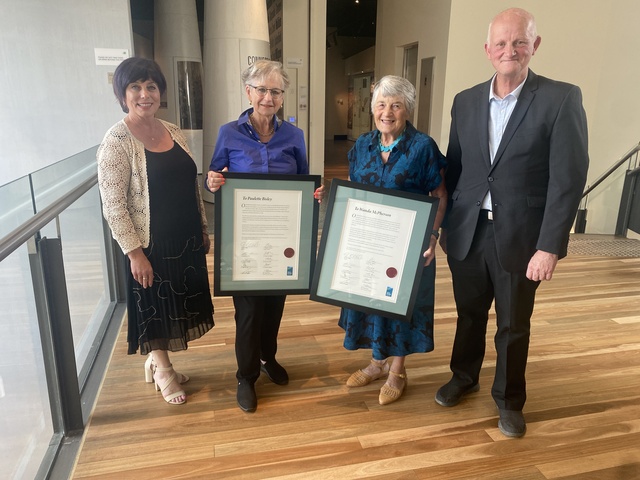
By Mikayla van Loon
While Lilydale is now known for its regional museum, it wasn’t always the case, only forming after a push from art lovers and historians to redevelop the town’s creative centre.
Decades ago, the community formed the Yarra Ranges Regional Museum Trust, in the hopes of establishing an archival base for the region’s history.
Two of its longest serving members, Wanda McPherson and Paulette Bisley decided late last year to step down from their long held positions of treasurer and chair.
In early March, the Trust formalised the process with a Letter Under Seal presentation, welcoming the Trust’s newest members Dino Conte as secretary and Angela Stainwell as treasurer, while Maria McCarthy has taken the helm.
Ms Bisley, prior to returning to the Yarra Valley, was a docent in both Singapore and Connecticut which fuelled her interest in preserving history.
Hearing the chatter of improving the museum, Ms Bisley said it didn’t take much convincing before she joined the committee.
“The museum was small, the shire was using it as its headquarters but we wanted to create a bigger and better place where you could store archives,” she said.
“To quote Dot Hill, she always said ‘Lilydale doesn’t have a heart, it doesn’t have a centre’ and we thought the museum would be a good start in establishing that.”
Ms Bisley said for a number of years the committee worked on raising funds, hosting concerts and quilt shows, around the turn of the new millennium.
With Lady Pamela Vestey as patron of the museum and Guill De Pury supporting the cause, the shire agreed to the redevelopment of the original 1890s Castella Street building.
But much of the negotiations, Ms Bisley said, surrounded the inclusion of a cafe in the design to continue towards that goal of a central hub.
“We insisted there should be room for a cafe, because it would be a regional museum, it would be the hub that the other community museums and historical societies would feed into the central hub,” she said.
“And I think we’re the first and only regional museum.”
With people from all backgrounds, from historians to musicians, immigrants and winemakers, to First Nations people, Ms Bisley said it was a “really interesting, integrated group” of people who came together to achieve the one goal.
“We wanted to have a place where we were up to international standards, where you could store things and have travelling exhibitions,” Ms Bisley said.
Crediting “the bones of the museum” to Sue Thompson, who as part of the Lilydale Historical Society led the museum until 1989 before the shire took over, Ms Bisley said helped immensely in building the basis of the archives and the vision.
“It’s a culmination of community activism,” she said.
“To have it to make us think about our past, to me, was very fundamental because museum’s have been used in the past to mould the current generation and their background and their values.
“There’s often, in societies, no place to learn about your basic roots and that’s where I think a museum has its value – to go back and see what your roots were. The Yarra Ranges is a melting pot of people and that’s its beauty.”
Trust chair Ms McCarthy said to have had Ms Bisley and Ms McPherson dedicate 20 years each to the Trust was invaluable.
“Together, they contributed 40 years of volunteer service to the Board of the Yarra Ranges Regional Museum Trust,” she said.
“Both women took their roles seriously with pride, strength, integrity, and steered the board forward in supporting the museum with their acquisition requests.
“The role of the Trust is to ensure good governance over the funds collected and donated to the Yarra Ranges Regional Museum and then to support the museum in acquisitions of regional importance.”
Ms McCarthy and Ms Bisley agreed that one of the highlights and notable achievements of the Trust was the ‘Oil Paint and Ochre’ exhibition and book.
“Our most memorable request was supporting the printing of the book, ‘Oil Paint and Ochre’.
“This book was a showcase of the exhibition of the same name, the amazing story of the relationship between William Barrak and the De Pury Family. This exhibition was truly an incredible event and was so successful it reached a national audience.”
Ms Bisley said the Trust allows the museum “the flexibility to purchase paintings in a hurry” if required but so too, it comes with the possibility of being outbid by collectors and much larger museums.
She was particularly disappointed with only being able to get a few letters some years ago in a Lady Pamela Vestey collection sale, which she regarded as “only one per cent of her collection”.
More recently, however, Ms McCarthy said the Trust has been successful in helping the museum acquire local Indigenous art works, the eel trap and Wilan Wilan.
Although time for her to step aside for new people to take the reins, Ms Bisley said she is “enormously proud of our museum”.
“It should continue to grow and be used,” she said.







